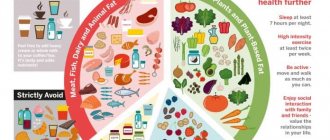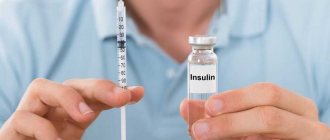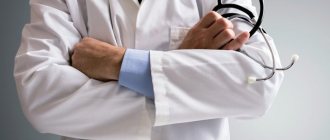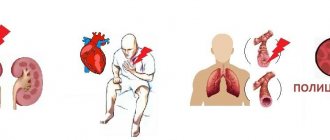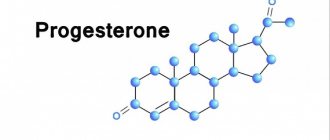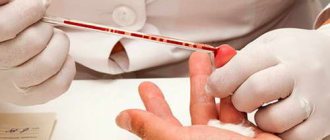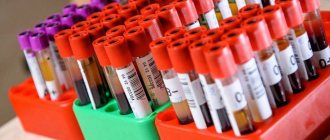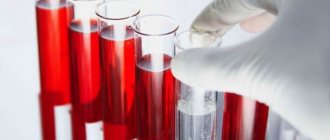Complexes with this research
Women's check-up No. 1 38 studies for annual preventive examination 19,290 ₽ Composition
Metabolic profile 5,900 ₽ Composition
Lipidogram. Diagnostics of atherosclerosis Analysis of pathologies of lipid metabolism and the risk of heart and vascular diseases 480 ₽ Composition
IN OTHER COMPLEXES
- Male anti-aging diagnostics RUB 13,300
- Women's anti-aging diagnostics RUB 12,070
- Monitoring the diet of a nursing mother RUB 2,940
- Nutritionist recommends RUB 7,570
- Advanced male anti-aging diagnostics RUB 33,710
Norms
Below is a table with cholesterol standards for males and females.
| Age category | Normal cholesterol levels in women | Normal cholesterol levels in men |
| 0-5 years | 2,91-5,19 | 2,95-5,25 |
| 5-10 years | 2,27-5,31 | 3,13-5,25 |
| 10-15 years | 3,22-5,21 | 3,09-5,23 |
| 15-20 years | 3,09-5,18 | 2,93-5,10 |
| 20-25 years | 3,16-5,59 | 3,16-5,59 |
| 25-30 years | 3,32-5,75 | 3,44-6,32 |
| 30-35 years | 3,37-6,58 | 3,57-6,58 |
| 35-40 years | 3,64-6,27 | 3,78-6,99 |
| 40-45 years | 3,81-6,53 | 3,91-6,94 |
| 45-50 years | 3,95-6,87 | 4,09-7,15 |
| 50-55 years | 4,20-7,08 | 4,09-7,17 |
| 55-60 years | 4,46-7,77 | 4,04-7,15 |
| 60-65 years | 4,46-7,69 | 4,12-7,15 |
| 65-70 years | 4,42-7,85 | 4,09-7,10 |
| 70-90 years | 4,49-7,25 | 3,73-7,86 |
As you age, cholesterol levels begin to rise. However, in males after 70 years of age, cholesterol in the blood may decrease sharply, which is considered a normal condition. Experts also note that women are much less likely than men to deposit “bad” cholesterol on the vascular walls due to the protective effect of female sex hormones.
What could be the causes of low blood cholesterol in women? Cholesterol levels may rise sharply during pregnancy, which is explained by hormonal changes. In addition, the pathological condition can cause a number of diseases.
Hypothyroidism is often the cause of hypocholesterolemia. Thyroid hormones take an active part in the process of regulating the level of cholesterol concentration in the circulatory system. In cases where the gland begins to produce a large amount of hormones, this means that the cholesterol level decreases sharply.
The indicator of the organic compound contained in the cell membranes (cholesterol) of an adult or adolescent is also influenced by the season. Mostly small fluctuations in the indicator occur in the winter months. Also, the results of a biochemical blood test can be affected by the phase of the menstrual cycle and the ethnic characteristics of the patient.
Biochemistry results are available after 12-20 hours
Detailed description of the study
Cholesterol is an essential substance for the functioning of the human and animal body. According to its biochemical structure, cholesterol (cholesterol) is an unsaturated steroid alcohol. The main place of its formation is the liver. It accounts for more than 50% of cholesterol synthesis in the body, the rest comes from food.
The functions of cholesterol are diverse - it is involved in the synthesis of hormones, bile acids in the liver, the formation of vitamin D3 in the skin, and is a structural component of the plasma membranes of absolutely all cells in the body.
Every day, up to 0.5-1 grams of cholesterol are formed in the body of both men and women. Additionally, about 300-500 grams are supplied with food. Normally, cholesterol levels remain in balance due to the fact that approximately the same amount (1-1.5 g/day) is consumed or excreted from the body along with feces, and less - with sebum.
Cholesterol cannot independently circulate in the blood, so it is transported as part of lipoproteins (LP) - these are complex proteins consisting of protein and a non-protein component (in this case, lipid). Depending on the density during ultracentrifugation, the following classes of lipoproteins are distinguished:
- HDL - high density lipoproteins, α-lipoproteins;
- LDL - low-density lipoproteins, β-lipoproteins;
- LDL - very low density lipoproteins, pre-β-lipoproteins;
- DILP - intermediate density lipoproteins, α2-β1 lipoprotein;
- Chylomicrons.
Chylomicrons transport cholesterol from the intestine through the venous portal system to the liver, where it is packaged into VLDL and released back into the blood. Next, VLDL, through many biochemical reactions (including with the help of HDL), is converted into LDLP, and then into LDL. This form is the main one for the transport of cholesterol to tissues, where this substance is involved in the life of cells.
LDL is called “bad” cholesterol due to its atherogenic properties. It is the high level of this cholesterol in the blood that is associated with severe systemic damage to the arteries - atherosclerosis. An increase in cholesterol levels in the blood (hypercholesterolemia, or dyslipidemia) is observed in people who are genetically predisposed to this condition, since a larger amount of this substance is formed in their liver. Along with this, the content of animal fats in the diet plays an important role. As a result of the development of atherosclerosis, the risk of cardiovascular disease (eg, myocardial infarction or stroke) may increase.
To assess LDL levels, a direct determination method, or the Friedwald equation, has been developed, where cholesterol is cholesterol, TG is triglycerides:
LDL cholesterol = Total cholesterol - HDL cholesterol - (TG/2.2) in mmol/l
Studying this indicator is important for people with a perceived increased risk of cardiovascular disease.
Symptoms
It is impossible to determine hypocholesterolemia by external manifestations. To determine cholesterol levels, the patient must take a biochemical blood test performed on an empty stomach. In cases where you cannot visit the hospital for some reason, you should pay attention to your own well-being.
Symptoms such as lack of appetite for a long time, decreased sensitivity, systematic weakness, fatigue, and the presence of fatty loose stools can signal low cholesterol.
Enlarged lymph nodes, rapid mood swings, and decreased sexual activity appear. The listed symptoms may indicate hypocholesterolemia, so it is important to urgently consult a doctor and get tested!
References
- Aster, D., Fausto, N., Vinay, K., et al. Fundamentals of disease pathology according to Robbins and Cotran. - M.: Logosphere, 2014. - 624 p.
- Severin, E.S., Aleynikova, T.L., Osipov, E.V. and others. Biological chemistry. - M.: Medical Information Agency LLC, 2008. - 364 p.
- Guyton, A., Hall, J. Textbook of Medical Physiology. 13th Edition, 2015.
- Mach, F., Baigent, C., Catapano, A. et al. ESC/EAS guidelines for the treatment of dyslipidaemias: lipid modification to reduce cardiovascular risk. Russian Journal of Cardiology, 2020. - Vol. 25(5). - P. 3826.
How to reduce LDL levels in the blood to normal?
To reduce elevated LDL cholesterol levels, it is critical to go beyond (just) taking “cholesterol pills.”
(of course, STRICTLY (!) as prescribed by the treating specialist), but also follow very important rules! First, radically change your ENTIRE diet and overhaul your lifestyle. After all, you must agree, will there be any benefit from taking special medications if you immediately ate an “egg sandwich” (maybe even a couple) and had no intention of quitting smoking at all!?
Basic recommendations for changing your diet:
- significantly limit the consumption of saturated fats/fried foods and (!) give up trans fats forever;
- significantly increase the amount of plant fiber consumed in your daily menu;
- drink, eat only low-fat dairy products (or with a minimum amount of fat);
- replace animal proteins with vegetable ones (Canadian scientists have found that soy protein (even 25 grams per day) reduces LDL levels by 4-5%, and with a complete replacement of meat/products - up to 20%);
- switch to OMEGA-3 / polyunsaturated fatty acids (they are found in fatty fish or flaxseed oils);
- Replace sweet juices and carbonated drinks with tea (ideally green!) or plain water.
More detailed information based on the recommendations of domestic and foreign treating specialists can be found at the links below:
- A complete list of the best foods that lower cholesterol and cleanse blood vessels
- Recommended diet for effectively reducing “bad” cholesterol in the blood
- How to quickly lower cholesterol at home (before using pills)
We also recommend that you familiarize yourself with the brief TABLE-REMINDER
(about permitted and harmful foods for elevated cholesterol levels in the blood).
And, plus everything, with a table of cholesterol content in food
.
Basic recommendations for lifestyle changes (after consulting a doctor):
- first of all, quit smoking - find another alternative to this dubious “joy of life” or contact psychologists;
- not only lose weight, but also become a calorie expert (read more about this in the article on reducing triglycerides
); - try to move as much as possible (do regular sports, walk more in the fresh air, swim, dance or ride a bike).
And finally, NEVER TREAT YOURSELF by taking the “best” medications, or following any “dubious diets” read from a “tabloid” magazine.
What does it mean if LDL cholesterol is low?
In general, decreased levels of LDL cholesterol (i.e., low-density lipoprotein cholesterol) are not clinically significant. Although, there are some reasons why this happens:
- familial (hereditary) hypocholesterolemia (hypocholesterolemia);
- severe liver diseases (in particular cirrhosis);
- oncological diseases (cancer) of the bone marrow;
- chronic alcohol intoxication (stage 2 alcoholism);
- hyperthyroidism (syndrome caused by hyperfunction of the thyroid gland);
- some inflammatory joint diseases;
- pernicious (or B12-deficiency) anemia (“malignant anemia”);
- inflammatory processes (in the body) or infectious diseases;
- COPD (Chronic Obstructive Pulmonary Disease).
VIDEO:
how are cholesterol (atherosclerotic) plaques formed in the walls of blood vessels (43 sec)?
Biochemistry analysis
The following categories of people must undergo an analysis for cholesterol and its LDL fraction in the lipid profile of blood biochemistry:
- To prevent atherosclerosis, especially for men after their 20th birthday, it is necessary to take a biochemical test for cholesterol with a lipid profile once every 3-5 years;
- If total cholesterol in biochemistry is increased, then it is necessary to make a lipid spectrum of the blood plasma, which includes a decoding of HDL, LDL, and triglycerides fractions, as well as an atherogenic index;
- Patients at risk of developing cardiac and vascular pathologies, especially systemic atherosclerosis. Pathologies that cause danger with high cholesterol - if the patient’s history includes cases of relatives of systemic atherosclerosis, embolism, myocardial infarction, stroke, or coronary syndrome, then blood biochemistry for cholesterol with a lipogram must be taken at least once a year;
- For arterial hypertension at very high levels, undergo blood biochemistry for lipid profile at least 1-2 times a year;
- If you have diabetes mellitus of the first and second tier, do a lipid profile at least 1 - 2 times a year;
- If a patient develops pathological obesity (in women, the waist circumference is greater than 80.0 centimeters, and in men, 94.0 centimeters), then this is a signal to do a blood test with a lipid spectrum to see the LDL level. More often than not, this level will be elevated because elevated LDL causes fat to accumulate in the body, which is deposited in the abdominal area and thighs. It is necessary to undergo biochemistry at least 2 times a year, and when treating excess weight, every quarter;
- If there is a disturbance in lipid metabolism, which leads to hypercholesterolemia;
- In case of IHD pathology, undergo biochemistry for LDL every 6 months;
- For aortic aneurysm, for atherosclerosis of the lower extremities - once every 6 months;
- For atherosclerosis of the coronary vessels, as well as the arteries of the neck and head, biochemistry is prescribed every 3 months, and in the treatment of atherosclerosis, once every 30 - 60 days;
- 30 days after the anti-cholesterol diet, it is necessary to take a biochemistry test for LDL.
It is necessary to take a biochemistry test for LDL levels
Norms
The norms for the content of cholesterol in plasma blood in men, as well as in the body of women by age:
| age category for adults | OX indicator for women unit of measurement in mmol/liter | cholesterol index for men unit of measurement in mmol/liter |
| from 20 years to 30 years | normal 3.10 - 5.160 | normal 2.90 - 5.050 |
| from 30 years to 40 years | from 3.30 to 5.790 | from 3.40 to 6.30 |
| from 40 years to 50 calendar years | ranging from 3,850 to 6,850 | ranging from 5.750 to 7.10 |
| from 50 years to 60 years | ranging from 4.050 to 7.30 | between 4.150 and 7.10 |
| from 60th birthday to 70th birthday | interval from 4,350 to 7,650 | from 4.0 to 7.150 |
| over 70 years of age | normal indicator 4.450 - 7.80 | normal index 4.050 - 7.050 |
Age/normal LDL
How to get tested?
To identify total cholesterol, as well as its fractions HDL, LDL and TG, and how high the LDL index is, it is possible only with the help of lipid biochemical analysis, the lipid spectrum method.
To do this, you need to prepare for analysis:
- Do not eat for 10 - 12 hours, but no longer. Long-term abstinence from food leads to depletion of body cells, which disrupts the correct level of cholesterol and its fractions;
- Dinner should be light and free of fatty foods and carbohydrates. It is better to eat boiled chicken or fish and a lot of fresh vegetables for dinner;
- Two per day, stop drinking alcohol;
- Do not smoke for one hour before donating blood;
- Do not perform heavy work or play sports during the day;
- You are allowed to drink a glass of purified water without gas before taking blood;
- Before donating blood, you need to sit quietly for about 15 minutes so that the body can relax and calm down;
- To take a cholesterol test, you must be in a good emotional mood;
- Do not take a biochemical test after an X-ray, ultrasound, MRI, angiography with contrast, or after physiotherapeutic procedures;
- If the patient is taking medications, then it is necessary to inform the doctor, but it is better to stop taking medications a week before the planned procedure;
- Stop taking antibacterial drugs, diuretics, hormonal contraceptives 7 - 10 days before the procedure.
Biochemistry analysis to identify the LDL index

